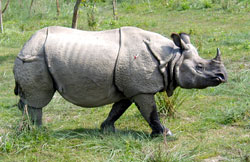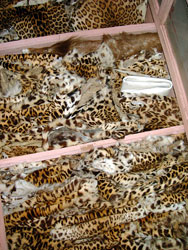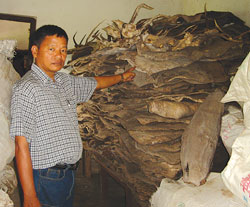 |
| IN THE WILD: Protecting the wild animals Three tiger cubs posing for a picture, |
The numbers tell a sad story. Chitwan National Park's population of one-horned rhinos has dropped from 544 in 2000 to only 372 today.
The 2005 rhino count found that 94 animals were lost to poaching while 66 died of natural causes such as fighting, predation, and age. "One of the major reasons why the number declined sharply is the state of the country," says Dr Shant Raj Jnawali, chief of monitoring evaluation and planning at the King Mahendra Trust for Nature Conservation (KMTNC).
For example, the number of anti-poaching posts in Chitwan fell from 32 to eight during the conflict. "Maoist attacks on the army posts moved the soldiers to headquarters instead, which gave poachers a good opportunity to be active," adds Jnawali.
|
|
| Seized tiger and leopard skins at the Armed Forest Guard Training Centre in Tikauli |
"Our latest data taken six months back shows that there are about 370 tigers in Nepal," says DNPWC Conservation Education Officer Laxmi Manandhar. This figure is up from 350 tigers three years ago and coincides with the tally of WWF Nepal, says Kanchan Thapa of the organisation's Terai Arc Landscape Program. Of that total number, 123 are breeding tigers, adds Thapa.
"There is very little evidence of tiger poaching in Nepal," said Thapa via email. "Overall the tiger population has been growing at the same time that habitat outside protected areas is also becoming favourable for tigers."
But experts caution that the tiger count, unlike that for rhinos, produces a very rough tally. "There's a nominal chance of missing out rhinos, it can happen only when they go to the inner part of the jungle, tigers are much more difficult to count," says Jnawali.
A team riding on the backs of about 30 elephants for about one month conducts the census, identifying individual animals. "We note down their inclination of the horn, arrangement of neck folds, nodes on the armour, length of tail, body scars, etc, to make sure that actual identification is done," Jnawali adds.
 |
| A one-horned rhino walking in Chitwan National Park. |
Today, conservationists have another ally. The young people of Chitwan's buffer zones have voluntarily banded together to protect the world-famous park's animals and forests.
At Mriga Kunja in the park's buffer zone, a group of youngsters has established the impressively named Banya Jantu Chori Sikar Niyantran Yuwa Jagaran Abhiyan. All have received training on anti-poaching techniques from park personnel and a network of informants recently helped arrest 77 poachers and their accomplices.
"We give out forms to veterinary stores so that they can record who has bought poisons," explains Birendra Mahato of the campaign to monitor the use of products used to poison rhinos. The group has already helped arrest a dozen poachers.
In New Padampur, 17 young villagers formed their own Youth for Anti-Poaching Campaign and the very next day caught a gang of 40 people illegally felling trees. "We seized three quintals of wood, 11 cycles and four axes from them," said Durga Prashad Acharya proudly. "We now plan to trace animal poachers."
Chitwan National Park's Kamal Jung Kunwar says: "If anti-poaching operations are to be strengthened, some form of incentive has to be given to informants and the army should resume patrolling."
|
|
| Captain Dhana Bahadur Thapa pointing at a stack of rhino skulls and skins captured from poachers, |
Kunwar says poachers send the tiger skins and rhino horns to Kathmandu from where they are smuggled across the border into Tibet. Smuggling is driven by the huge price differential: 100g of rhino horn fetches $1,000 when it ends up in China, which explains why so many people are willing to risk capture and punishment. The China smuggling route is expected to be easier with the arrival of the railway to Lhasa and better trans-Himalayan access.
Delegates from Nepal, China and India met in Beijing on 22 June to discuss measures to curb the growing cross-boundary wildlife trade. Their major concern was the trade in rhinos, elephants, Tibetan antelope and, particularly, tiger parts, which are reported to have the highest value. Traditional Chinese medicine markets were cited as a key market for the products in all three countries.




